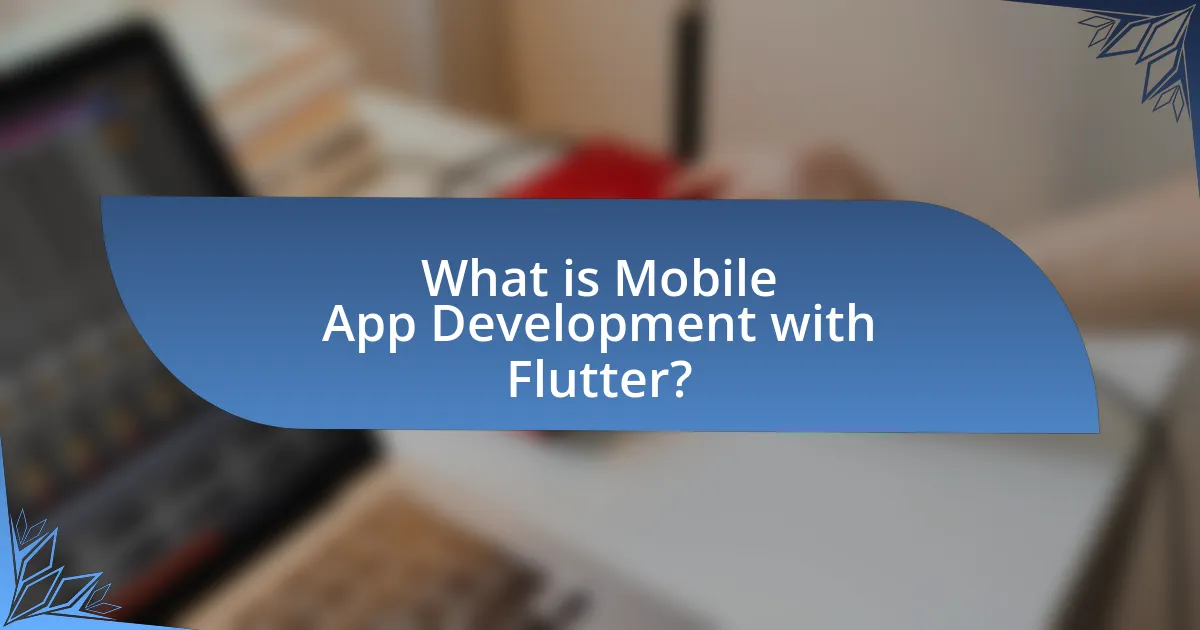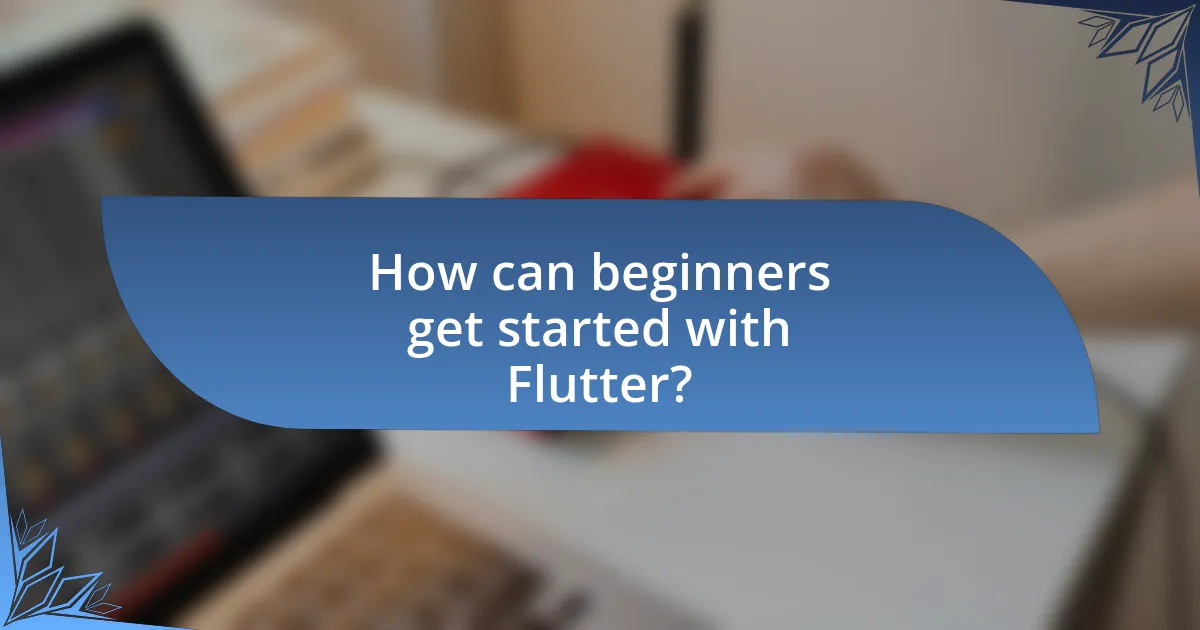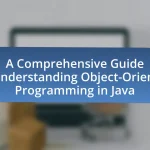Mobile app development with Flutter is a process that utilizes the Flutter framework, created by Google, to build applications for multiple platforms from a single codebase using the Dart programming language. This article provides a comprehensive overview of Flutter, detailing its key features such as cross-platform capabilities, a rich set of pre-designed widgets, and the hot reload functionality that enhances development efficiency. It also explores the essential components of Flutter, the role of Dart, and the tools available for developers, while addressing common challenges faced by beginners and best practices for effective app development. Additionally, the article highlights the advantages of using Flutter over other frameworks and offers guidance on how newcomers can start their journey in mobile app development with this powerful tool.

What is Mobile App Development with Flutter?
Mobile app development with Flutter is the process of creating applications for mobile devices using the Flutter framework, which is developed by Google. Flutter enables developers to build natively compiled applications for mobile, web, and desktop from a single codebase, utilizing the Dart programming language. This framework is known for its fast development cycle, expressive UI, and high performance, as it compiles to native ARM code and provides a rich set of pre-designed widgets. According to a 2021 survey by Stack Overflow, Flutter was one of the most loved frameworks among developers, highlighting its growing popularity and effectiveness in mobile app development.
How does Flutter facilitate mobile app development?
Flutter facilitates mobile app development by providing a single codebase that allows developers to create applications for both iOS and Android platforms simultaneously. This cross-platform capability significantly reduces development time and costs, as developers do not need to write separate code for each platform. Additionally, Flutter’s rich set of pre-designed widgets and its customizable UI components enable developers to create visually appealing applications quickly. The framework also includes a hot reload feature, which allows developers to see changes in real-time without restarting the application, further enhancing productivity. According to a survey by Stack Overflow, Flutter has gained popularity among developers, ranking as one of the most loved frameworks, which underscores its effectiveness in streamlining the mobile app development process.
What are the key features of Flutter that support app development?
Flutter supports app development through its key features, including a single codebase for multiple platforms, a rich set of pre-designed widgets, hot reload functionality, and strong community support. The single codebase allows developers to write one set of code that runs on both iOS and Android, significantly reducing development time and effort. The rich set of pre-designed widgets enables developers to create visually appealing interfaces quickly, while hot reload allows for real-time updates during development, enhancing productivity. Additionally, Flutter’s strong community support provides access to numerous resources, libraries, and plugins, facilitating easier problem-solving and feature implementation.
How does Flutter differ from other mobile development frameworks?
Flutter differs from other mobile development frameworks primarily through its use of a single codebase for both iOS and Android applications, which enhances development efficiency. Unlike frameworks such as React Native or Xamarin, which rely on native components, Flutter utilizes its own rendering engine to create widgets, allowing for a consistent look and feel across platforms. This approach enables developers to achieve high performance and a rich user interface without the need for platform-specific code. Additionally, Flutter’s hot reload feature allows for real-time updates during development, significantly speeding up the iteration process compared to traditional frameworks.
Why choose Flutter for mobile app development?
Flutter is chosen for mobile app development due to its ability to create natively compiled applications for mobile, web, and desktop from a single codebase. This cross-platform capability significantly reduces development time and costs, as developers can write code once and deploy it across multiple platforms. According to a survey by Stack Overflow, Flutter is favored by 42% of developers for its fast development cycle and expressive UI, which enhances user experience. Additionally, Flutter’s hot reload feature allows developers to see changes in real-time, further streamlining the development process.
What advantages does Flutter offer to developers?
Flutter offers developers advantages such as a single codebase for multiple platforms, fast development through hot reload, and a rich set of pre-designed widgets. The single codebase allows developers to write one set of code that runs on both iOS and Android, significantly reducing development time and effort. Hot reload enables developers to see changes in real-time without restarting the application, enhancing productivity. Additionally, Flutter’s extensive library of customizable widgets facilitates the creation of visually appealing and responsive user interfaces, which can improve user experience. These features collectively streamline the app development process and enhance the overall efficiency for developers.
How does Flutter enhance user experience in mobile apps?
Flutter enhances user experience in mobile apps by providing a rich set of customizable widgets and a fast development cycle. The framework allows developers to create visually appealing interfaces that are responsive and adaptive to different screen sizes, ensuring a consistent experience across devices. Additionally, Flutter’s hot reload feature enables real-time updates during development, allowing for immediate feedback and iteration, which significantly improves the overall user experience. This capability is supported by Flutter’s single codebase for both iOS and Android, reducing development time and ensuring uniformity in design and functionality across platforms.

What are the essential components of Flutter?
The essential components of Flutter include the Flutter framework, Dart programming language, widgets, and the Flutter engine. The Flutter framework provides a rich set of pre-designed widgets that facilitate the development of user interfaces, while Dart serves as the programming language that enables developers to write the application logic. Widgets are the building blocks of a Flutter app, allowing for the creation of both simple and complex UI elements. The Flutter engine, which is built in C++, handles rendering, file I/O, and other low-level tasks, ensuring high performance across platforms. These components work together to create a cohesive environment for mobile app development, making Flutter a powerful tool for developers.
What programming languages are used in Flutter development?
Dart is the primary programming language used in Flutter development. Flutter, developed by Google, utilizes Dart for building natively compiled applications for mobile, web, and desktop from a single codebase. Dart’s features, such as just-in-time (JIT) and ahead-of-time (AOT) compilation, enhance performance and development speed, making it suitable for Flutter’s reactive framework.
How does Dart play a role in Flutter applications?
Dart is the primary programming language used to develop Flutter applications. It enables developers to write code that is compiled into native machine code for both iOS and Android platforms, ensuring high performance and a smooth user experience. Dart’s features, such as a rich standard library, strong typing, and asynchronous programming support, facilitate the creation of responsive and efficient applications. Additionally, Flutter’s framework is built on Dart, which allows for a seamless integration of UI components and logic, enhancing the development process.
What are Flutter widgets and how do they function?
Flutter widgets are the fundamental building blocks of a Flutter application, representing both the visual and functional components of the user interface. Each widget in Flutter is an immutable description of part of the user interface, and they can be combined to create complex UIs. Widgets function by being organized in a tree structure, where each widget can contain other widgets, allowing for a hierarchical arrangement that defines the layout and behavior of the app. This structure enables Flutter to efficiently manage updates and redraws, as it only rebuilds the parts of the UI that have changed, optimizing performance.
What tools and resources are available for Flutter developers?
Flutter developers have access to a variety of tools and resources that enhance their development experience. Key tools include the Flutter SDK, which provides the necessary libraries and tools for building applications, and Dart, the programming language used for Flutter development. Additionally, developers can utilize IDEs like Android Studio and Visual Studio Code, which offer plugins for Flutter that streamline coding and debugging processes.
Resources such as the official Flutter documentation, available at flutter.dev/docs, provide comprehensive guides and tutorials. Community forums like Stack Overflow and the Flutter community on GitHub offer platforms for developers to seek help and share knowledge. Furthermore, packages from the Dart package repository, pub.dev, allow developers to easily integrate third-party functionalities into their applications. These tools and resources collectively support Flutter developers in creating efficient and high-quality mobile applications.
Which IDEs are best suited for Flutter development?
The best IDEs for Flutter development are Android Studio, Visual Studio Code, and IntelliJ IDEA. Android Studio is the official IDE for Android development and provides robust support for Flutter through plugins, including features like a rich editor, debugging tools, and an integrated emulator. Visual Studio Code is lightweight and highly customizable, offering a variety of extensions that enhance Flutter development, such as Dart and Flutter plugins that provide code completion and debugging capabilities. IntelliJ IDEA, particularly the Ultimate version, also supports Flutter development with similar features to Android Studio, making it suitable for developers who prefer a more comprehensive development environment. These IDEs are widely recognized in the Flutter community for their efficiency and feature sets, making them ideal choices for both beginners and experienced developers.
What libraries and packages can enhance Flutter applications?
Flutter applications can be enhanced using libraries and packages such as Provider, Riverpod, Dio, and Flutter Bloc. Provider is widely used for state management, allowing developers to efficiently manage and share application state. Riverpod, an improvement over Provider, offers a more robust and flexible approach to state management. Dio is a powerful HTTP client for making network requests, providing features like interceptors and global configuration. Flutter Bloc facilitates the implementation of the BLoC (Business Logic Component) pattern, promoting a clear separation of business logic from UI code. These libraries and packages are popular in the Flutter community, as evidenced by their extensive documentation and active user support, making them reliable choices for enhancing Flutter applications.

How can beginners get started with Flutter?
Beginners can get started with Flutter by installing the Flutter SDK and setting up an integrated development environment (IDE) like Visual Studio Code or Android Studio. The Flutter SDK provides the necessary tools to develop applications, while the IDE offers features like code completion and debugging. According to the official Flutter documentation, after installation, beginners should create their first Flutter app using the command line or IDE, which helps them understand the framework’s structure and components. Engaging with the Flutter community through forums and tutorials can further enhance their learning experience.
What are the first steps to set up a Flutter development environment?
To set up a Flutter development environment, first, install the Flutter SDK by downloading it from the official Flutter website. This SDK includes the Flutter framework and necessary tools for development. Next, ensure that you have a compatible IDE, such as Android Studio or Visual Studio Code, which supports Flutter development through plugins. After installing the IDE, add the Flutter and Dart plugins to enable Flutter development features. Finally, verify the installation by running the command “flutter doctor” in the terminal, which checks for any dependencies that need to be addressed. This process is essential for creating and running Flutter applications effectively.
How do you install Flutter on different operating systems?
To install Flutter on different operating systems, follow these steps for each OS:
For Windows, download the Flutter SDK from the official Flutter website, extract the zip file to a desired location, and add the Flutter bin directory to your system’s PATH environment variable. For macOS, download the Flutter SDK, extract it, and add the Flutter bin directory to your PATH in the terminal. For Linux, use the terminal to download the Flutter SDK, extract it, and similarly add the Flutter bin directory to your PATH.
These installation methods are validated by the official Flutter documentation, which provides detailed instructions tailored for each operating system.
What are the initial configurations needed for a Flutter project?
To set up a Flutter project, the initial configurations required include installing the Flutter SDK, setting up an editor (such as Android Studio or Visual Studio Code), and configuring the environment variables. The Flutter SDK must be downloaded from the official Flutter website, and the installation path should be added to the system’s PATH variable to enable command-line access. Additionally, the editor must have the Flutter and Dart plugins installed to facilitate development. These configurations ensure that the development environment is ready for building and running Flutter applications.
What are some common challenges faced by beginners in Flutter?
Beginners in Flutter commonly face challenges such as understanding the widget tree structure, managing state effectively, and dealing with asynchronous programming. The widget tree structure can be complex, as Flutter relies heavily on a hierarchy of widgets to build the user interface, which may confuse newcomers. Additionally, state management is crucial for maintaining the app’s data flow, and beginners often struggle to choose the right approach, whether it be Provider, Riverpod, or Bloc. Asynchronous programming presents another hurdle, as Flutter uses Future and Stream classes to handle operations that take time, which can be difficult for those unfamiliar with these concepts. These challenges are well-documented in various Flutter community forums and tutorials, highlighting the learning curve associated with mastering the framework.
How can beginners troubleshoot common Flutter errors?
Beginners can troubleshoot common Flutter errors by systematically analyzing error messages, checking the Flutter documentation, and utilizing community resources. Error messages often provide specific information about the issue, guiding users to the source of the problem. The Flutter documentation is comprehensive and includes troubleshooting sections that address frequent errors, ensuring users have access to reliable solutions. Additionally, community forums such as Stack Overflow and the Flutter GitHub repository offer insights from experienced developers who have encountered similar issues, providing practical solutions and workarounds. This approach is effective because it combines direct information from the error messages with established resources, enhancing the troubleshooting process for beginners.
What resources are available for learning Flutter effectively?
To learn Flutter effectively, several resources are available, including official documentation, online courses, and community forums. The official Flutter documentation provides comprehensive guides and tutorials, making it a primary resource for beginners. Online platforms like Udemy and Coursera offer structured courses that cover Flutter development from basics to advanced topics, often featuring hands-on projects. Additionally, community forums such as Stack Overflow and the Flutter community on Reddit provide platforms for asking questions and sharing knowledge, enhancing the learning experience through peer support. These resources collectively facilitate a thorough understanding of Flutter for aspiring developers.
What best practices should beginners follow in Flutter development?
Beginners in Flutter development should follow best practices such as structuring code effectively, utilizing widgets efficiently, and adhering to the Flutter framework’s conventions. Structuring code involves organizing files and directories logically, which enhances maintainability and readability. Efficient widget usage means leveraging Flutter’s rich set of pre-built widgets to minimize custom code, thereby speeding up development and ensuring consistency. Adhering to Flutter conventions, such as using the ‘pubspec.yaml’ file correctly for dependencies and following the Material Design guidelines, ensures that applications are both functional and visually appealing. These practices are supported by the Flutter documentation, which emphasizes the importance of code organization and widget utilization for optimal performance and user experience.
How can code organization improve Flutter app development?
Code organization significantly improves Flutter app development by enhancing maintainability, scalability, and collaboration among developers. Well-structured code allows developers to easily navigate the project, making it simpler to identify and fix bugs or implement new features. For instance, following the BLoC (Business Logic Component) pattern in Flutter promotes separation of concerns, which leads to cleaner code and easier testing. According to a study by Google, organized codebases reduce onboarding time for new developers by up to 30%, demonstrating that effective code organization directly impacts productivity and project success.
What design principles should be considered when developing with Flutter?
When developing with Flutter, key design principles include consistency, feedback, and accessibility. Consistency ensures that the app’s UI elements behave and appear uniformly, which enhances user familiarity and ease of use. Feedback is crucial as it informs users about actions taken, such as button presses or loading states, thereby improving user experience. Accessibility involves designing apps that are usable by people with disabilities, which can be achieved by following guidelines such as providing text alternatives for images and ensuring sufficient color contrast. These principles are supported by Flutter’s Material Design guidelines, which emphasize a cohesive user experience across different platforms.


